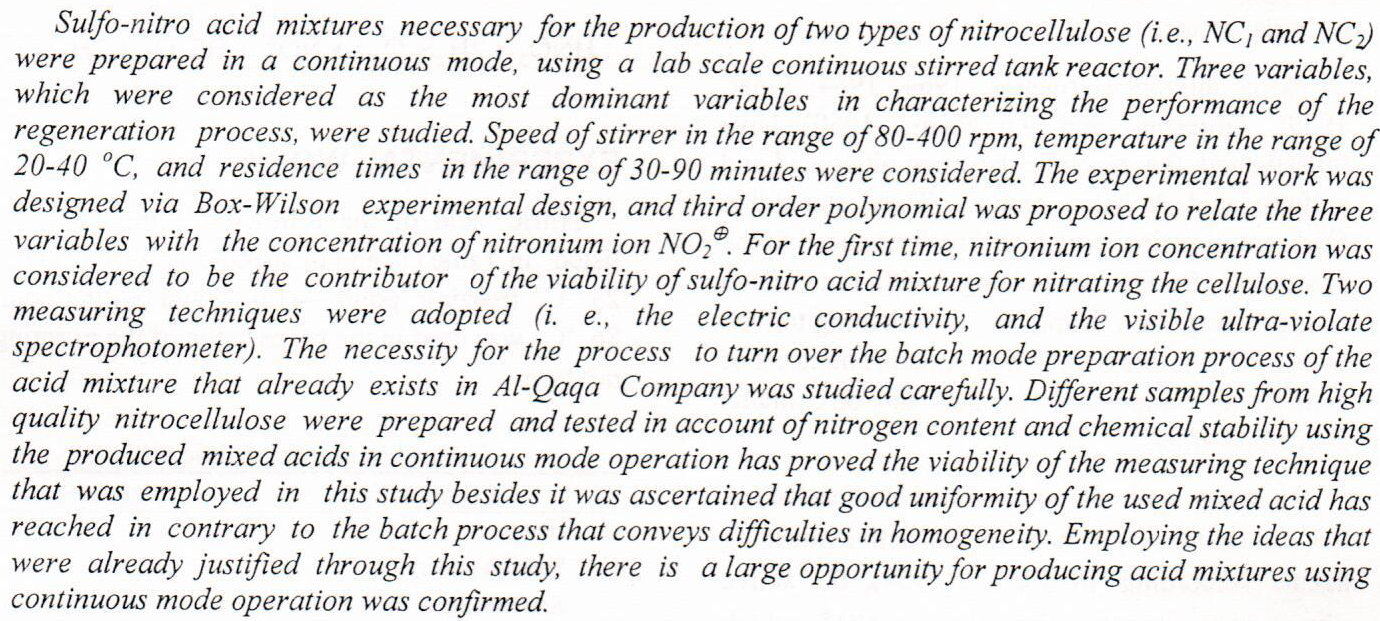
The spectral characteristics and the nonlinear optical properties of the mixed donor (C-480) acceptor (Rh-6G) have been determined. The spectral characteristics are studied by recording their absorption and fluorescence spectra. The nonlinear optical properties were measured by z-scan technique, using Q-switched Nd: YAG laser with 1064 nm wavelength. The results showed that the optimum concentration of acceptor is responsible for increasing the absorption and the emission bandwidth of donor to full range and to 242 nm respectively by the energy transfer process, also the efficiency of the process was increased by increasing the donor and acceptor concentration. The obtained nonlinear properties results of the mixture C-480/ Rh-6G showed
... Show MoreThis study examined the correlation between binder-level fatigue properties and mixture-level cracking resistance in asphalt binders modified with five Nanomaterials (NMs): Nano-Silica (NS), Nano-Alumina (NA), and Nano-Titanium dioxide (NT) at 2%, 4%, and 6% as well as Nano-Zinc oxide (NZ) and Carbon Nanotubes (CNTs) at 1%, 2%, and 3%. Modified binders were subjected to Rolling Thin-Film Oven Test (RTFOT) and Pressure Aging Vessel (PAV) aging and tested at 25 °C using the Linear Amplitude Sweep (LAS) test to determine fatigue life (Nf) and the fatigue parameter G*.sin δ. The corresponding asphalt mixtures were evaluated using the IDEAL-CT test. The results indicated strong correlations between binder and mixture performance for
... Show MoreThis research aims to design a high-speed laser diode driver and photodetector, the result is the
design of the high-speed laser diode driver with a short pulse of 10 ns at 30 KHz frequency and the
delivered maximum pulse voltage is 5.5 mV. Also, its optical output power of the laser diode driver is
about 2.529 mW for the centroied wavelength 1546.7 nm with FWHM of 286 pm and (1270-1610) nm.
The design of the circuit based on bipolar transistor where the input pulse signal is simply generated by
an arduino kit with 15 kHz frequency and then compensated to trigger to small signal amplifier which
was is simply NPN C3355 transistor and the output is a current driver to the laser diode. OptiSystem
software and Electronic
The present study was conducted to determine the effect of different concentrations of putrescine and spermidine at all stages of regeneration (callogenesis, somatic embryos multiplication, germination and rooting)) of date palm cultivar Barhee. Shoot tips were eradicated from 2-3 years old offshoots, surface sterilized and inoculated onto Murashiege and Skoog, 1962 (MS) medium supplemented with 20 mg/L 2,4-D and 3 mg/L N6-2-isopentyl adenine (2ip). Primary callus was obtained after 24 weeks on the nutrient medium. Calli were then transferred onto fresh MS medium containing 0.0, 50, 100 or 150 mg/L of putrescine or spermidine individually. Results were recorded after 12 weeks. A significant increase in embryonic callus fresh weights reached
... Show More (3)
(3)
 (4)
(4)
 (2)
(2)
Although rare, coarctation of aorta is a treatable cause of hypertension, transcatheter dilatation by balloon with or without stent are a well-known treatment strategy
the first part of the research involves investigate the aspect of the radiation superposed on the one bright soliton pulse propagated on ideal single mode
The study investigated the behaviour of asphalt concrete mixes for aggregate gradations, according to the Iraqi specification using the Bailey method designed by an Excel spreadsheet. In mixing aggregates with varying gradations (coarse and fine aggregate), The Bailey method is a systematic methodology that offers aggregate interlocking as the backbone of the framework and a controlled gradation to complete the blends. Six types of gradation are used according to the bailey method considered in this study. Two-course prepared Asphalt Concrete Wearing and Asphalt Concrete binder, the Nominal Maximum Aggregate Sizes (NMAS) of the mixtures are 19 and 12.5 mm, respectively. The total number of specimens was 240 for both layers (15 samp
... Show More (3)
(3)
Because of the experience of the mixture problem of high correlation and the existence of linear MultiCollinearity between the explanatory variables, because of the constraint of the unit and the interactions between them in the model, which increases the existence of links between the explanatory variables and this is illustrated by the variance inflation vector (VIF), L-Pseudo component to reduce the bond between the components of the mixture.
To estimate the parameters of the mixture model, we used in our research the use of methods that increase bias and reduce variance, such as the Ridge Regression Method and the Least Absolute Shrinkage and Selection Operator (LASSO) method a
... Show MoreA simple analytical method was used in the present work for the simultaneous quantification of Ciprofloxacin and Isoniazid in pharmaceutical preparations. UV-Visible spectrophotometry has been applied to quantify these compounds in pure and mixture solutions using the first-order derivative method. The method depends on the first derivative spectrophotometry using zero-cross, peak to baseline, peak to peak and peak area measurements. Good linearity was shown in the concentration range of 2 to 24 µg∙mL-1 for Ciprofloxacin and 2 to 22 µg∙mL-1 for Isoniazid in the mixture, and the correlation coefficients were 0.9990 and 0.9989 respectively using peak area mode. The limits of detection (LOD) and limits of quantification (LOQ) were
... Show More